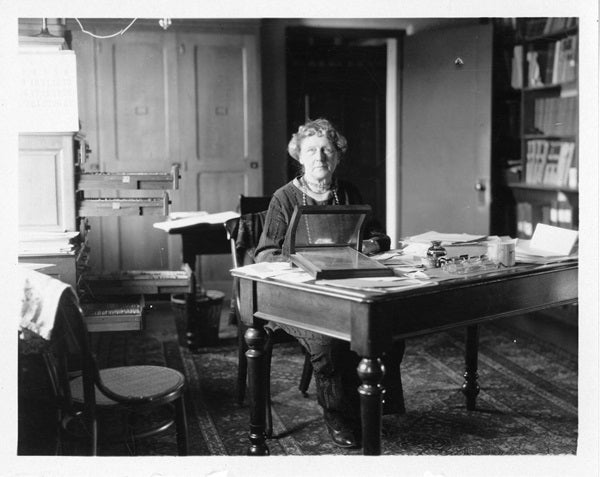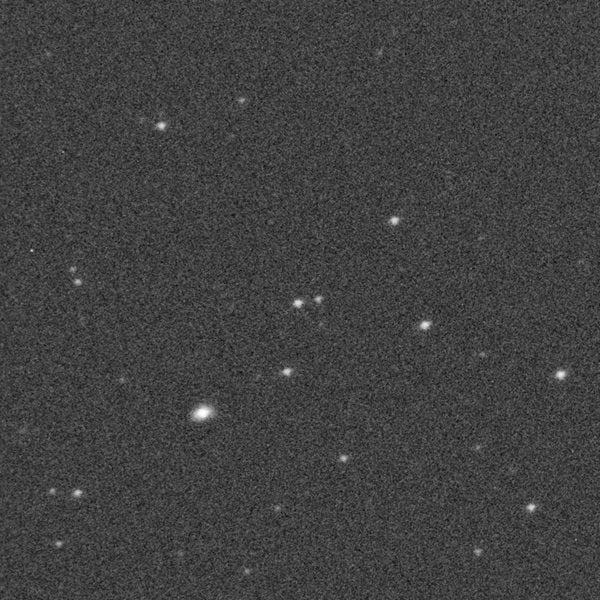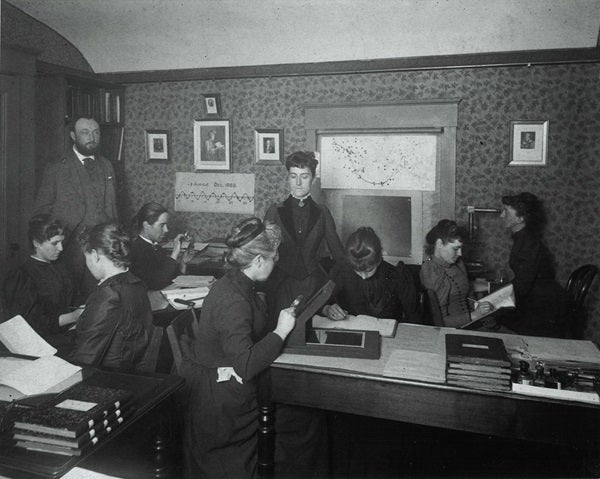We love photographs for the way they capture a moment, a smile, a friendship — although sometimes we don’t realize the camera’s luck for years. The same is true of photographs of the stars.
One particular collection of astronomical images has fed the minds and calculations of scientists making some of the most important discoveries of their times. The Harvard College Observatory’s collection contains more than half a million images of the stars chemically stamped onto glass rectangles, the oldest created during the 1880s. The story of the people behind the plates is told beautifully in Dava Sobel’s new book The Glass Universe. The book ends around World War II, but the collection certainly doesn’t, with plates made until 1989. Astronomers are still using the collection, and even finding new ways to keep it scientifically useful. “I don’t think anybody has ever made a list of what the discoveries were from the plate stacks because they were used in a lot of other ways,” said Owen Gingerich, an astronomer and historian of science at Harvard..
There were—and still are—other collections of astronomical plates, but Harvard’s is far and away the largest, and unlike many, it covers both the northern and southern skies. It was begun under the leadership of observatory director Edward Pickering, who also made a point of hiring talented female mathematicians and astronomers. “Pickering realized that he should be recording the whole sky photographically in both hemispheres, and that had never been done before,” said John Hearnshaw, an astronomer and historian at the University of Canterbury in New Zealand. “He also realized that what astronomy needed was collecting data on a massive scale.”
There are two types of plates. The majority are photographic: clear glass sheets scattered with dark specks of stars. Today, these plates draw the most interest from scientists. But about one in five is a spectrographic plate, with each star depicted as a grey smear (representing the rainbow of visible light) perhaps a quarter inch long. In the early days of the collection, these spectra were the cutting edge of astronomy.
The first major developments to come out of the Harvard plate collection were systems that classified stars based on the tiny white lines slicing the spectrum’s grey rainbow. “It’s almost incomprehensible that this was all done visually by examining the plates under magnifying glasses,” said Josh Grindlay, an astronomer at Harvard. “Thank heavens they did because it was not something that just immediately popped out, what this spectral classification system was.”
The first system was designed by Williamina Fleming, whom Pickering originally hired as a housemaid only to discover her astronomical potential. Fleming’s system, published in 1890, sorted more than 10,000 spectra into an alphabetical sequence of 15 letters. A second, independent system—complicated and criticized for its complexity—was created by Antonia Maury and used 22 letters, with further subclasses denoting how wide or narrow certain spectral lines were. (Years later, astronomers realized some of these characteristics identify binary stars and supergiants.).
These two systems were expanded and reconciled by Annie Jump Cannon, whom Grindlay calls a “wonder woman.” Over her career, Cannon classified more than 350,000 spectra on the Harvard plates, sometimes managing a hundred in one day. “She was an extraordinary woman who did one thing extremely well all her life,” said Hearnshaw. In her free time, she also spotted 300 variable stars and five novae Cannon built on Fleming’s and Maury’s work to create the O, B, A, F, G, K, M sequence that still underlies stellar classification.
Nevertheless, other astronomers likely could have tackled the classification problem. “This would have been done, but not in the concerted way that it was done here,” Grindlay said. Hearnshaw agreed, pointing particularly to observatories in California and Germany. “Harvard was a pioneer, but they had other people chasing on their tails, and of course that’s good for science.”
The spectrographic plates had another secret hidden among their streaks: the recipe for stars, deciphered by Cecilia Payne-Gaposchkin. Scientists elsewhere had tied specific elements and their charged varieties to the wavelengths of light they absorb, which match the white lines chopping through a spectrum; Payne-Gaposchkin applied this work to translate the Harvard spectra into elemental ingredients.
“What she found was that the stars all seemed enormously uniform in composition,” Gingerich said. “The spectra looked very different, but that was because of the temperature difference of the stars.” Hot hydrogen and very hot hydrogen have very different spectra, but both are hydrogen. “That was a very important finding,” he added. Payne-Gaposchkin’s work also proved that the vast majority of the universe is hydrogen and helium.
Even while the spectra were still unveiling their secrets, the photographic plates were beginning to shine, thanks to what is widely recognized as the single most important discovery to come out of the Harvard plates.
Astronomers wanted to sort out how bright different stars were — but there’s usually no way to determine whether a star looks bright because it’s nearby or because it’s genuinely a bright star. Harvard astronomer Henrietta Leavitt looked at the Large and Small Magellanic Clouds and saw clusters of stars.
“She could see there was this big clump of what looked like a gazillion stars,” said Grindlay. “It was clearly one thing.” Stars clumped together must all be about the same distance from Earth—which in turn meant the ones that appeared brighter really were brighter. By studying a specific type of variable star, called Cepheids, in the Magellanic Clouds, Leavitt realized that brighter Cepheids took longer to dim and brighten, establishing a relationship between intrinsic luminosity and period.
That relationship meant astronomers could reverse the process: Measuring how quickly a Cepheid brightens and dims would reveal “how many watts were in the lightbulb,” said Grindlay, and from there, “out pops the distance.” That conversion required other techniques to pin down how far away specific Cepheids were, Gingerich added. But Edwin Hubble was still able to use Leavitt’s work to prove the Milky Way and Andromeda were two separate galaxies.
The collection’s full-sky scope was crucial for Leavitt, since the clouds are only visible from the often-ignored southern hemisphere. Other galaxies could have yielded the same realization, but they were too far away for the small telescopes of the time to truly see into them. “It would have been very difficult and I would say essentially impossible without having the Magellanic Clouds,” Grindlay said.
In general, the plates are best for studying things that appear, move, or change over time. They spotted Pluto before it was officially discovered and they let astronomers link supernovae to their predecessor stars. Scientists have used the plates as one tool to study the variations of Tabby’s Star. Recently the plates have helped astronomers find stars that may brighten and dim as slowly as once a century.
David Turner, an astronomer at Saint Mary’s University in Canada, particularly likes using the plates to study variables with periods that are inconveniently long for observing. “Getting the periods of these things is actually problematic,” he said Turner, noting the hassle of scrambling for time on telescopes and battling the weather. “When you have 100 years of observations at your beck and call, it’s kind of great.”
Even when the plates can’t solve the whole puzzle, they’re a good place to start. “The plates are sort of a discovery ground for new types of phenomena that stars and galaxies can be undergoing,” Grindlay said, pointing out that more modern telescopes can then provide more detailed spectra to solve the mystery.
And they can offer a different way of seeing something. During the 1960s, astronomers unraveled the secret of quasars—originally discovered with radio telescopes—by matching the radio sources to fast-varying star-sized objects. The combination of traits meant quasars had to be cosmically tiny but hugely powerful, which only supermassive black holes and their gigantic appetites could explain. “We wouldn’t have known what these objects were doing without a record of the sky,” said Grindlay.
Now, the plates are informing modern science, thanks to a project Grindlay oversees that is digitizing them. To make the endeavor “scientifically interesting,” he wanted to produce not just images, but also their initial analysis.
But you can’t scan the plates like you would your vacation photos. “We have to do things with precision, so we’re scanning down to the grain of the images,” said Jessica Mink, who helped write software for the project. That detail means “we get a pretty accurate idea of the brightness, of how exposed the grain is.” Then her computer program can line up individual pixels with maps of the sky.
Mink says that if all goes well, astronomers should be able to connect the digitized plate data with sky surveys produced by the Large Synoptic Survey Telescope beginning in the early 2020s. Melding the data would greatly expanding the time-sequence that can be studied, since the LSST project’s scope is only 10 years.
But even when it comes to the history of the plates themselves, there may still be more to learn. As Harvard astronomers were taking and studying the plates, they also kept more than 2,000 notebooks, a collection now under the supervision of head librarian Daina Bouquin and her colleagues at Harvard Observatory’s library. Bouquin is leading a project to sort, catalog, scan, and transcribe the materials. “We can make new discoveries, essentially, from these old handwritten notes,” she said.
“We’ve found some really gorgeous gems that we think are obviously of interest to the community,” Bouquin said. “We also have just math, a lot of math.” But hidden among those scribbled numbers could be the secrets of a star we’ve never even glanced at, twinkling through time.












